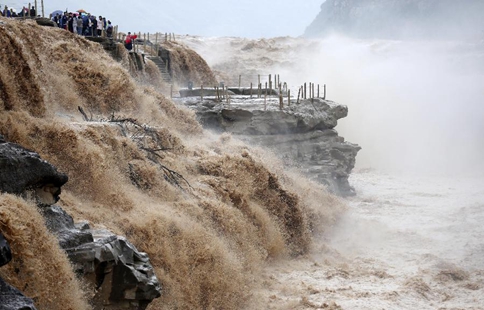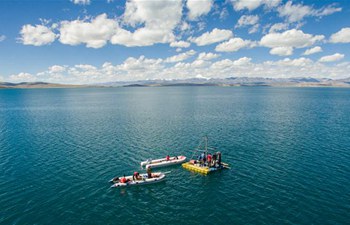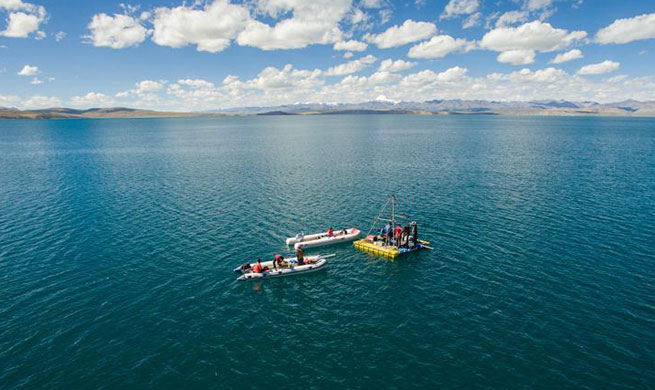by Xinhua writer Guo Shuang
LOS ANGELES, Sept. 5 (Xinhua) -- Four decades after they left Earth, humanity's farthest and longest-lived mission, the U.S. National Aeronautics and Space Administration (NASA)'s twin spacecraft Voyager 1 and Voyager 2, are still calling home as they fly deeper into the space.
"A MISSION THAT CHANGED EVERYTHING"
"In exploration terms, Voyager was and still is, to me and to so many, the Apollo 11 of space science. It's a mission that changed everything," Thomas Zurbuchen, NASA's deputy administrator, said Tuesday during a news conference on the mission.
The day marks the 40th anniversary of the launch of Voyager 1, which is drifting through interstellar space at about 38,000 miles (61,155 km) an hour, nearly 13 billion miles (21 billion km) from Earth.
On Sept. 5, 1977, Voyager 1 spacecraft launched from Cape Canaveral, Florida, only a little over eight years after the blast-off of Apollo 11 in 1969.
Its sister craft, Voyager 2, which launched two weeks earlier, trails shortly behind, nearly 11 billion miles (17.7 billion km) from its starting point. Together, the two Voyager probes have vastly expanded our knowledge of what lies beyond Earth.
"It not only changed what we know, but how we think. It's about exploration of the unknown, and redefining what we can and cannot do as humans," Zurbuchen said.h As originally designed, the Voyagers were to conduct close-up studies of Jupiter and Saturn, Saturn's rings, and the larger moons of the two planets.
Since the twin-probe launches in 1977, Voyager 1 and 2 have transmitted astounding views of the solar system back to Earth, giving scientists the first close-up looks of Jupiter and Saturn's planetary systems, plus Uranus and Neptune.
Now, 40 years later, the twin spacecraft are now far beyond the planets in the solar system and Voyager 1 is currently speeding through the space between stars.
Voyager 1 successfully flew by both the Jupiter and Saturn systems before continuing out into the farthest most reaches of our solar system. It has been observing the interplanetary medium throughout its journey, according to NASA.
"Voyager 1 launched second, but it is traveling the fastest. It's in interstellar space as of August 25th, 2012," said Suzann Dodd, Voyager project manager at NASA's Jet Propulsion Laboratory (JPL). The researchers said they anticipate Voyager 2 reaching that boundary within the next few years.
MESSAGE IN BOTTLE TOSSED IN COSMIC OCEAN
Many renowned scientists now believe contacting extraterrestrials is not a good idea. Among them, Stephen Hawking recently warned that "meeting an advanced civilization could be like Native Americans encountering Columbus."
The theoretical physicist "has expressed a kind of sense like don't let them (other civilizations) know we are here," Ann Druyan, Creative Director of Voyager Interstellar Message, said, "but it's too late for that."
Both Voyager 1 and 2 famously carried with them the Golden Record, a 12-inch gold-plated copper disk containing sounds and images selected to portray the diversity of life and culture on our planet to extraterrestrials.
The message consisted of greetings in 55 human languages, and the salutations of humpback whales, as well as 118 images, 27 pieces from the world's great musical traditions and an essay written in sound that tells the story of our planet from its earliest formation, through the evolution of life and development of technology up to the present.
Like a time capsule, the Golden Record is expected to last nearly 5 billion years. Each disk is encased in a protective aluminum jacket along with a cartridge and a needle. Instructions explaining from where the spacecraft originated and how to play the disk are engraved onto the jacket, according to NASA.
It is like a message in a bottle tossed in the cosmic ocean. Space is mostly empty, so the chances of either of them being received are very small.
However, "this record represents our hope and our determination, and our good will in a vast and awesome universe," according to the excerpt from former U.S.president Jimmy Carter's official statement placed on the Voyager 1 spacecraft.
On Tuesday, William Shatner, famous for playing Captain Kirk in the original "Star Trek" series and movies, helped to send a special message to Voyager spacecraft at NASA's Jet Propulsion Lab (JPL).
Out of 30,000 submitted, the message, which was originally submitted on Twitter by @Asperger_Nerd, was chosen by popular vote to transmit to the distant spacecraft.
"We offer friendship across the stars. You are not alone," the message reads. Continuing to travel outward, Voyager carries the message to the stars.
VOYAGERS ARE "AS HEALTHY AS SENIOR CITIZENS CAN BE"
Many assumed that the twin spacecraft would lose contact with home by now. However, even with 40 years of space flight behind them, the Voyagers are still sending back valuable data.
Today, Voyager 1 and 2 are "as healthy as senior citizens can be", said Suzanne Dodd, the Voyager project manager. "Each of them has had different ailments over the years."
For example, "Voyager 2 is tone-deaf: every time we send a command to the spacecraft we have to put it in two different frequencies in order for the spacecraft to hear it. Voyager 1 does not have an operating plasma science instrument, and what that means is Voyager 1 cannot really directly feel the solar wind and the high-energy charged particles coming from the sun," Dodd said.
Next, scientists will have to decide which instruments to turn off to conserve power from the spacecraft's nuclear generators, some instruments should be running until at least 2025, and maybe longer.
"I hope that I can sit here 10 years from now with all these folks and talk about the 50th anniversary of Voyager launch and still have them flying," Dodd said.
Communications will be maintained until the spacecraft's nuclear power sources can no longer supply enough electrical energy to empower critical functions.
Until then, there's still much to learn about the boundary of our heliosphere and what lies beyond in the space between the stars, according to NASA.
"From many points of view, Voyager really represents humanity's most ambitious journey of discovery," Voyager principal investigator Edward Stone said. "It's really I think legacy".
Space is the "newest realm of human activity," and a new frontier for mankind, the renowned American space scientist told Xinhua in an earlier interview. Enditem

















